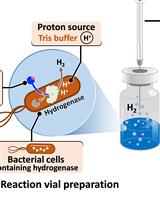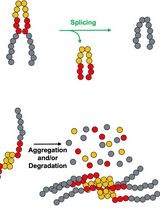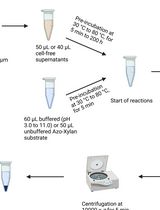- EN - English
- CN - 中文
Superoxide Dismutase (SOD) and Catalase (CAT) Activity Assay Protocols for Caenorhabditis elegans
秀丽隐杆线虫中超氧化物歧化酶(SOD)和过氧化氢酶(CAT)活性测定实验方案
发布: 2017年08月20日第7卷第16期 DOI: 10.21769/BioProtoc.2505 浏览次数: 38639
评审: Peichuan ZhangKristin ShinglerAnonymous reviewer(s)
Abstract
Assays for superoxide dismutase (SOD) and catalase (CAT) activities are widely employed to indicate antioxidant responses underlying the toxic effects of test chemicals. Yet, earlier studies mainly described the procedures as performed according to manufacturer’s instructions without modifications that are specific to any organisms. The present protocol describes the steps in analyzing the superoxide dismutase (SOD) and catalase (CAT) activities in C. elegans, which is a model organism that can be used to study effects of pharmaceutical compounds and environmental pollutants. The main steps include: (1) sample preparation; (2) total protein assay; (3) SOD activity assay; (4) CAT activity assay; and (5) medium list and formula, and also data analysis and performance notes.
Keywords: SOD (SOD)Background
Biomarkers are essential to examine biological and pathogenic processes in response to a chemical, an agent or a therapeutic intervention. Various biological processes in organisms result in reactive oxygen species (ROS) which cause oxidative stress. In response to such oxidative stress, organisms can deploy superoxide dismutase (SOD) and catalase (CAT) to scavenge ROS so as to protect the cellular homeostasis (Balaban et al., 2005). On the one hand, various chemicals (pollutants) can retard such antioxidant responses, and disturb the health of organisms including human beings. On the other hand, many pharmaceuticals aim to strengthen the antioxidant responses to improve health. Therefore, activities of SOD and CAT are very important to reflect potential effects of chemicals or/and pharmaceuticals.
Caenorhabditis elegans (C. elegans) is a model organism that has been used to study effects of pharmaceutical compounds (Dengg and van Meel, 2004; Carretero et al., 2017) and environmental pollutants (Yu et al., 2013a and 2017). Several studies have used SOD and CAT assays to indicate the antioxidant responses and potential mechanism underlying the toxic effects of test chemicals (Feng et al., 2015; Yu et al., 2012; 2016 and 2017). However, these studies simply described that the determination was carried out, by using a generic kit protocol without species-specific modifications. Therefore, the explicit protocols to perform SOD and CAT assays in C. elegans are still needed for better specific instruction.
In the present protocol, we provide a nematode protocol with experimental details to analyze SOD and CAT activities in C. elegans.
Materials and Reagents
- Pipette tips (https://online-shop.eppendorf.com)
- Plate (60 mm)
- Centrifuge tubes, 1.5 ml (Eppendorf, catalog number: 022364111 )
- Absorbent paper (KCWW, Kimberly-Clark, catalog number: 0131 )
- 96-well plate, with lids (Corning, Costar®, catalog number: 3599 )
- Sealing tape, for 96-well plates (Thermo Fisher Scientific, Thermo ScientificTM, catalog number: 15036 )
- Nematodes (wild type N2)
Note: These nematodes are treated according to each researcher’s experiments. In the present protocol, the nematodes only have difference in numbers. - BCA protein assay kits (Thermo Fisher Scientific, Thermo ScientificTM, catalog number: 23225 or 23227 )
- Protein standard (5 mg/ml)
- BCA reagent A and B
- Protein standard (5 mg/ml)
- SOD assay kits (Beyotime Biotechnology, catalog number: S0101 )
- Reaction initiation solution
- SOD detection buffer
- WST-8
- Enzyme solution
- Reaction initiation solution (40x)
- Reaction initiation solution
- CAT assay kits (Beyotime Biotechnology, catalog number: S0051 )
- Enzyme conjugate
- Wash solution 40x
- Substrate A and B
- Stop solution
- Enzyme conjugate
- Sodium hydrate (NaOH), Analytic Reagent (Sinopharm Chemical Reagent, catalog number: 10019762 )
- Sodium hypochlorite (Antiformin, NaOCl, with 6-14% active Cl), Analytic Reagent (ALADDIN, catalog number: S101636-500 ml )
- Potassium phosphate dibasic (K2HPO4), Analytic Reagent (Sinopharm Chemical Reagent, catalog number: 20032118 )
- Potassium phosphate monobasic (KH2PO4), Analytic Reagent (Sinopharm Chemical Reagent, catalog number: 10017618 )
- Clorox solution (see Recipes)
- Phosphate buffered saline/buffer (PBS), pH 7.0 (see Recipes)
Equipment
- Pipettes
- Microscope
- Centrifuge, Eppendorf 5417R (Eppendorf, model: 5417 R , catalog number: 01396)
- Pestles, Eppendorf (Eppendorf, catalog number: F0140010 )
- Motor-driven tissue grinder (Beijing Baiwan Electronic Technology, catalog number: HG215-LH-A )
- Ice bath, in centrifuge tube box
- Microplate reader, BioTek (BioTek Instruments, model: Epoch )
- Sterilized bottle, Fisherbrand (100 ml, Fisher Scientific, catalog number: FB800100 ; 250 ml, Fisher Scientific, catalog number: FB800250 ; 500 ml, Fisher Scientific, catalog number: FB800500 )
- Magnetic stir bar
- Magnetic stir plate
- pH meter
- Incubator, Yiheng (Yiheng, model: LRH-1000F )
Procedure
文章信息
版权信息
© 2017 The Authors; exclusive licensee Bio-protocol LLC.
如何引用
Zhang, J., Chen, R., Yu, Z. and Xue, L. (2017). Superoxide Dismutase (SOD) and Catalase (CAT) Activity Assay Protocols for Caenorhabditis elegans. Bio-protocol 7(16): e2505. DOI: 10.21769/BioProtoc.2505.
分类
微生物学 > 微生物生物化学 > 蛋白质 > 活性
生物化学 > 蛋白质 > 活性
您对这篇实验方法有问题吗?
在此处发布您的问题,我们将邀请本文作者来回答。同时,我们会将您的问题发布到Bio-protocol Exchange,以便寻求社区成员的帮助。
Share
Bluesky
X
Copy link












